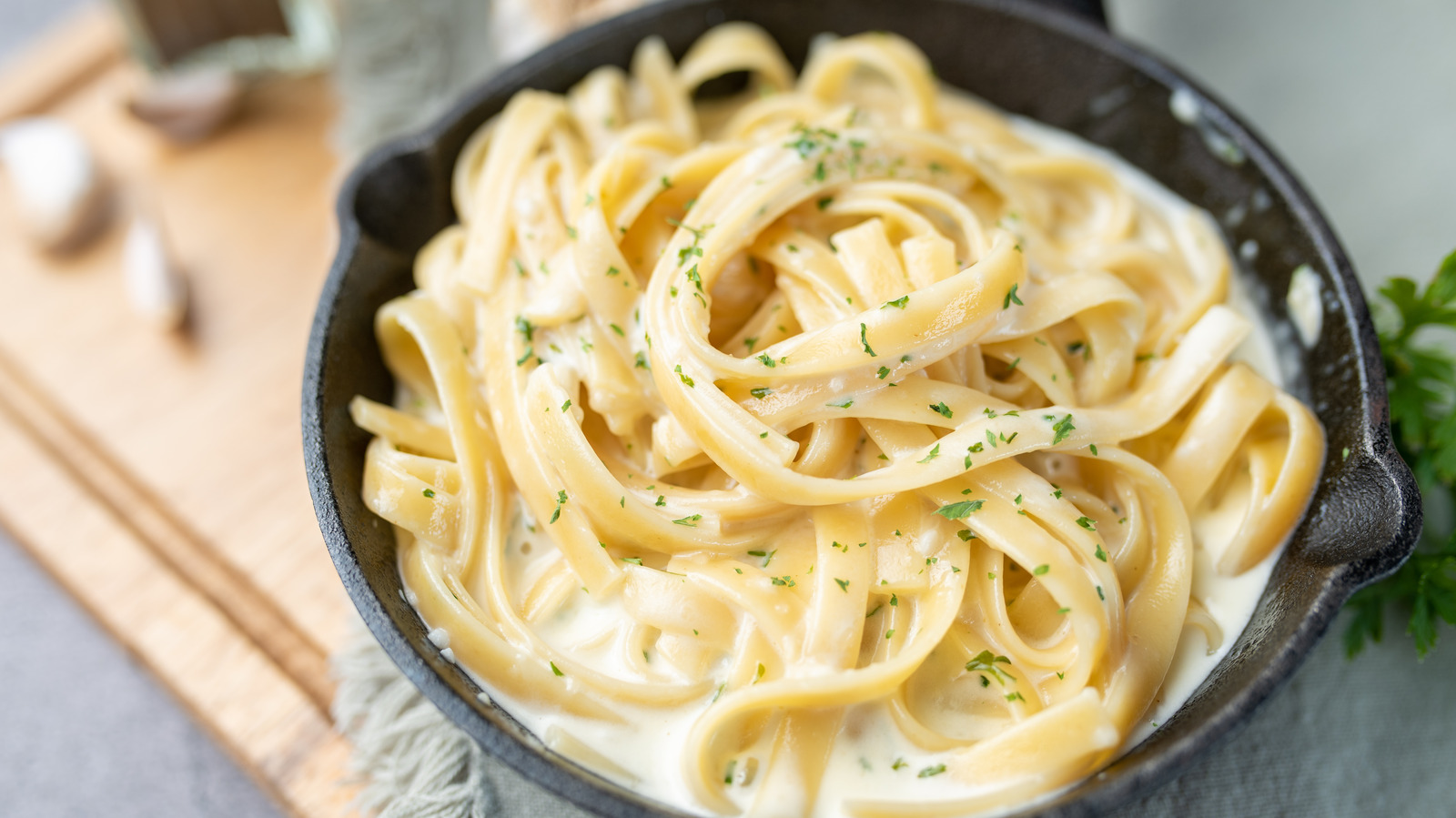
16 Common Mistakes Everyone Makes With Alfredo Sauce – Tasting Table
Alfredo sauce is one of the fundamental pasta sauces all cooks and home chefs should know how to make. There are numerous origin stories for the first alfredo recipe; one is that Alfredo di Lelio, an Italian chef, made the sauce for his ailing wife in the early 1900s (via Ozy). Fettuccine alfredo was introduced to the U.S. when two honeymooners (and silent movie stars) named Mary Pickford and Douglas Fairbanks brought the dish back to their favorite Hollywood restaurant, Musso and Frank Grill, from a trip to Italy in 1927.
Alfredo sauce includes a few staple ingredients, like parmesan cheese, butter, heavy whipping cream, and herbs. The creaminess of the butter and the cream make alfredo sauce a decadent topping for pasta and all its accompaniments. We’re here to help you craft the best date night alfredo recipe guaranteed to impress your loved ones and slowly become a staple for your meal rotation.
Not starting with a roux
 Marian Curko/Shutterstock
Marian Curko/Shutterstock
The key to making decadent thick sauces is to prepare a roux. A roux is made with equal parts of fat and starch — butter and flour are the most common combination. The roux is cooked on a stove to thicken it; this also produces a darker color depending on the amount of time it’s being heated. White roux is the most mild-flavored of the roux types. Since it’s cooked for less than five minutes (which is just long enough to remove the taste of the flour), the sauce doesn’t alter the flavor of your sauce too much.
If you love the creamy, cheesy flavor of the alfredo, you should stick to this kind of roux. A blonde roux is cooked slightly longer than a white roux — the smell is nutty, and its color is darker than a white roux. Although the blonde roux has more flavor than the white roux, it may alter the color of your alfredo sauce.
Not adding cream cheese
 Eivaisla/Getty Images
Eivaisla/Getty Images
Cream cheese might seem like an unconventional ingredient to add to a pasta sauce. But adding cream cheese to your alfredo sauce will make it taste much better. The cream cheese adds a thickening element to your sauce and a mild tangy flavor that makes your alfredo sauce unique. Also, if you use cream cheese in your recipe, you may consider skipping the preparation of a roux.
You’ll want to add cream cheese to your sauce when you combine your dairy ingredients. Once you add your whipping cream and the cream cheese, you’ll want to keep stirring the sauce to combine and evenly distribute the ingredients. Using a whisk rather than a spatula can help spread the sauce’s ingredients and craft a better texture — which is especially important for a creamy sauce like alfredo. It is equally as important to remember always to use unflavored cream cheese in your recipe — after all, something tells us that strawberry doesn’t pair well with fettuccini.
Forgetting an egg for flavor
 gowithstock/Shutterstock
gowithstock/Shutterstock
Pasta purists may say that adding an egg to a cream sauce is a cardinal sin, but we think it’s a good idea. Adding an egg yolk to any white sauce — whether it’s velouté, béchamel, or alfredo — adds an unprecedented boost of fatty flavor to your pasta sauce. The egg yolk also acts as a binder for the ingredients in your sauce, per Gobble. This means you can mix the thin sauce with a runny egg yolk to help bring it back together. You can also add the egg yolk to the roux to help improve the flavor.
The primary precaution you need to consider when adding eggs to your sauce is the heat. For ideal emulsification when making or fixing a broken sauce, you need to keep the sauce at a low simmering temperature. If you add the egg yolk to a sauce that is too hot, you may find that the egg yolk scrambles and splits.
Using a cheese other than parmesan
 Fudio/Getty Images
Fudio/Getty Images
Parmesan is a critical ingredient to add to alfredo sauce. According to Forbes, true Italian fettuccini only contains butter and parmesan. It is believed that Alfredo Di Lelio’s first recipe was made with triple cream butter, pasta made with a ton of eggs, and Parmigiano-Reggiano cut from the inside of the wheel.
If you’re going to make alfredo, you need to use parmesan cheese. It has the perfect sharp flavor and subtle dryness that your pasta sauce needs. If you don’t have parmesan, you can use other cheeses, but the sauce won’t be alfredo. The Kitchen Knacks notes Gruyere might be a good option because it has a more salty and milder flavor than parmesan. Piave is a hard cow’s milk cheese with a taste similar to parmesan but a crumbly texture. If you want to deviate from the texture and flavor of dried cheese, you can use mozzarella instead. But since mozzarella is a much more moist cheese, your alfredo sauce will be considerably runnier and not the same as a drier cheese.
Using pre-grated parmesan
 Ahanov Michael/Shutterstock
Ahanov Michael/Shutterstock
If you’re making alfredo for the first time, you may be inclined to buy bagged parmesan from the store rather than grating your own. According to Livestrong, one of the reasons why your alfredo sauce gets grainy is because your pre-bagged cheese contains anti-caking agents. The purpose of the anti-caking agents is to prolong parmesan’s shelf-life and prevent the cheese from clumping in a high moisture environment. However, the anti-caking agents are not conducive to the homemade sauce (via Food Insight). If you want a smooth sauce, you should grate your cheese at home rather than buy it in a bag.
The best tool for grating your parmesan cheese is a microplane shredder. This tool ensures the size of the cheese is very fine, so it is distributed into the sauce rather than forming solid lumps. The small particle size also means that the parmesan can easily reach its melting point, meaning that your sauce will be smooth and creamy in no time.
Adding cold cream to your sauce
 Kabardins photo/Shutterstock
Kabardins photo/Shutterstock
The easiest way to mess up your alfredo sauce is not to get the temperature correct. Adding cold ingredients to a hot sauce can drastically affect its texture. Recipedia notes that adding cold cream or milk to the rest of your sauce ingredients is not a good idea because the cream’s proteins and fats react with the heat to form clumpy curds. It’s the same reason you shouldn’t add cold cream to hot coffee.
According to Recipedia, you must temper cold milk before adding it to the rest of your ingredients on the stove. To correctly temper your sauce, it is recommended to add a bit of the sauce into the cream (rather than vice versa) to help bring the cream up to temperature. Then, once the cream is warm, you can add the entire cream back into the sauce without worrying about clumping. Although this might take a couple of extra steps (and dirty another kitchen tool), the end texture of your sauce will be entirely worth it.
Use the wrong kind of pasta
 Viktoriia Drobot/Getty Images
Viktoriia Drobot/Getty Images
While we do love all types of pasta, there are some shapes best suited to alfredo. The best pastas for alfredo sauce are long, flat noodles like pappardelle, linguine, and the classic fettuccini. According to the Food Network, these flat pasta shapes have a high surface area and can uphold the heavy weight of a dense sauce. A thinner pasta shape, like spaghetti or a bucatini, may disintegrate when mixed with the sauce.
Although it is unconventional to use short pasta with alfredo, ridged pasta shapes like ziti and penne have a high surface area that can be conducive to holding the sauce. And if you never learned how to twirl pasta using a fork-and-spoon, you can use a short pasta shape as an excuse. Regardless of what pasta you want, you should always salt the water after it starts boiling. This will add more flavor to your noodles.
Putting your sauce on top of the pasta
 Alexander Prokopenko/Shutterstock
Alexander Prokopenko/Shutterstock
One of the biggest mistakes people make with alfredo is spooning the sauce on top of the pasta rather than mixing it with the pasta. If you plop the sauce on top, it will make the sauce either too thick, such as in the case of a cream sauce, or oily, if you’re using a sauce made with mostly butter. You should instead stir the sauce directly into the noodles to maximize the impact of the starch from the noodles and create an ideal emulsification between your sauce and your pasta.
There are several methods to emulsify your pasta noodles and the sauce better. The idea is to finish off your noodles in the sauce. You can cook your noodles al dente and then add them to your sauce for the last few minutes. The leftover starch on your noodles will also thicken your sauce.
Not adding meat to your alfredo
 Foodio/Shutterstock
Foodio/Shutterstock
Alfredo and pasta is a blank canvas for cooking — which is why we love mixing the alfredo sauce with some protein. Some of the most common types of protein mixed into pasta include shrimp and chicken. You can use frozen shrimp with the tails removed; it will keep the price of your dish low and relatively easy to make; all you’ll have to do for a shrimp alfredo recipe is thaw your seafood, toss it with a pad of butter, and add it into the sauce and the cooked noodles when it’s time to serve. If you want to amp up the flavor in your pasta and get in a crunchy veggie boost, we recommend adding some cooked broccoli, spinach, or fresh cherry tomatoes.
If you have a shellfish allergy (or don’t like shrimp’s texture), you can also grill chicken and toss it in for a classic chicken fettuccine alfredo recipe. Just make sure to cook the chicken until it’s golden brown, about 8 to 10 minutes, before mixing it with your pasta and sauce.
Cooking your sauce on too high of a temperature
 HannaTor/Shutterstock
HannaTor/Shutterstock
Pasta sauce is notoriously temperamental — most of it stems from the heat over which the sauce is cooked. If you cook your sauce at too high a temperature, it can quickly transform into a broken sauce. The science behind this is simple. Alfredo is made by emulsifying fat and starches together — but if this precarious balance is messed up, the ingredients can split into their respective parts again.
Besides being patient and slowly introducing the fat to the starch, you can control your emulsification by moderating the heat between your ingredients. If you cook your alfredo sauce at too high a temperature, your starches will weaken and not work together to bind the ingredients. The trick with alfredo sauce is to slowly increase the heat and constantly stir to avoid allowing the starches to separate. You should also slowly add the cold and warm ingredients to temper the reaction.
Skimping on the butter
 stockcreations/Shutterstock
stockcreations/Shutterstock
We never said alfredo sauce was “healthy” — it is made with copious amounts of cheese, cream, and butter, after all. The butter in alfredo sauce is an emulsifier, which helps bring all of the ingredients together in your sauce (via Stella Culinary). According to America’s Test Kitchen, cold butter can help fix broken sauces because when it melts, it disperses fat into tiny droplets throughout the water. Slowly adding the butter in small chunks can help emulsify the broken sauce over time. Adding too much butter at any time (like dumping a whole stick of butter into the sauce) means you’ll open up opportunities for larger fat molecules and weaker emulsification — meaning your sauce won’t stay thick.
If you want a perfectly thick sauce, you should cube your butter and wait until the entire cube melts before adding more butter. Then, constantly whisk the sauce to prevent the sauce from burning and for better distribution of the ingredients.
Not thickening your sauce correctly
 Olga Miltsova/Shutterstock
Olga Miltsova/Shutterstock
The only thing worse than a split sauce is a thin sauce. You can thicken your alfredo sauce in several ways, but some work more effectively than others. Adding more grated cheese to your sauce can boost its flavor; just be sure to add only enough cheese so that your sauce comes together. Or, you can add less liquid (meaning heavy cream or milk) to your sauce. Martha Stewart recommends reducing the amount of heavy cream in your recipe by half for a creamier sauce or by a third if you want the richest sauce possible. When you cook the cream with other ingredients, you’ll find that the water evaporates and leaves behind the less-liquidy, unctuous butterfat.
The tried-and-true method for thickening sauces — whether for stir fry or pasta — is a cornstarch slurry. Mix equal parts cornstarch and water and add it to your sauce. You must let the sauce come to a simmer to activate the cornstarch. Leaving time for this to occur will yield delicious benefits.
Reheating your dish in the microwave
 Salvomassara/Shutterstock
Salvomassara/Shutterstock
If you’re lucky enough to have leftover alfredo sauce and pasta, you’ll need to ensure it’s stored correctly so you can enjoy it for the longest time possible. According to Pantry and Larder, there are several ways to reheat the dish without causing splitting. The first, which the outlet recommends the most, is to add a bit of liquid (cream, milk, or stock) to a saucepan over medium-low heat. Then, stirring vigorously, mix your room-temperature (or microwaved for a few seconds) pasta into the pan. You should use a large pan to ensure that there is a wide surface area and evenly-distributed heat to toss your pasta. You’ll also want to work quickly to prevent the sauce from splitting. You can also use a double boiler to reheat your pasta with a splash of cream or stock. The steam from the broiler will gradually heat the sauce without causing splitting.
You can heat your pasta in the microwave in a pinch — but you have to work slowly. It’s recommended to heat the container at 20-second intervals with your pasta covered by a paper towel. This serves two purposes, to prevent splitting and to keep your pasta moist.
Not taking jarred alfredo seriously
 Bloomberg/Getty Images
Bloomberg/Getty Images
Making alfredo sauce isn’t easy, but what self-respecting home cook would ever use jarred alfredo sauce? We would!
Alfredo sauce in a jar is much easier to cook than homemade sauce, especially when you need a quick meal. Our favorite product is Giovanni Rana’s Alfredo Sauce. The ingredients are simple — heavy cream, parmesan, onions, and Pecorino Romano. The sauce is white in color, creamy, and full-bodied compared to the other brands sampled. Another high-ranking brand was Newman’s Own, which can be stored in your pantry until it’s opened. Reviewers found the flavor of this sauce to be full of garlic and onions, with a mild saltiness.
Red flags on the ingredient list of jarred alfredo include added oils, milk powder, and powdered eggs. You should look for a brand that keeps it real with the critical elements of alfredo — cheese, butter, cream, and herbs. The closer you get to the classic recipe, the more your dinner guests will think that you made the sauce yourself.
Adding cream to your pasta
 Michelle Lee Photography/Shutterstock
Michelle Lee Photography/Shutterstock
The classic alfredo sauce recipe did not contain any cream. The simple ingredients of butter, cheese, and pasta water can bring alfredo sauce back to its origins. Omitting cream from your sauce makes this rendition of alfredo much lighter and allows the cheese flavor to shine through. All you need to do is melt the butter in a pan and add finely grated parmesan. Before your pasta is done cooking, you’ll need to scoop out ½ cup of pasta water and mix it into your sauce. The starches from the pasta will help cause the sauce to condense and form a nice silky coating around your cooked pasta.
This traditional alfredo sauce pairs well with filled pasta like ravioli and tortellini and thick noodles like tagliatelle. Filled pasta would get otherwise dulled by the cream of a modernized Alfredo sauce, so removing the cream from the equation allows you to focus on the meaty or cheesy fillings in the pasta.
Omitting fresh herbs
 Tanya Consaul Photography/Shutterstock
Tanya Consaul Photography/Shutterstock
Dense creamy alfredo causes you to get “lost in the sauce” — or whatever the kids say nowadays. Television star and cookbook author Lidia Bastianich recommends adding fresh herbs like sage to alfredo sauce. Sage is an Italian herb with citrine and eucalyptus-like notes. Its unique, standout taste does not get drowned in the sauce — like the traditional pairing of fresh parsley.
Bastianich adds sage leaves with classic cream, pasta water, butter, and cheese to make her sauce. Bastianich uses Grana Padano, but other related cheese would also work. It’s essential to add the sage leaves at the end of the cooking process to retain the organic flavors of the leaves. Then, after the ingredients have simmered for a few minutes, you can add your al-dente pasta and a cheesy garnish. We recommend chopping up some fresh parsley to add to your pasta after it’s finished cooking; these leaves are bright and crunchy and provide a bit of color to an otherwise nude-colored dish.







































































